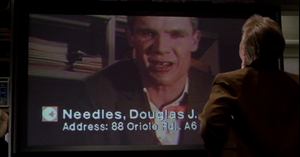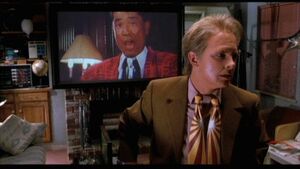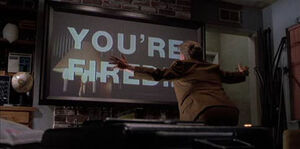
Marty McFly talking to Needles via video telephone, with Needles' datafile (his 'Address' details are shown here) appearing at the bottom of the screen.

"McFly!" Mr. Fujitsu suddenly appears on the screen as Marty is about to leave the living room.

Marty finds himself "terminated" by Mr. Fujitsu.
A video telephone was an invention that allowed someone to view the other person on a television screen while talking. AT&T marketed some video telephones by 2015, as well as providing video payphones like the one present in Courthouse Square.
On October 21, 2015, Marty McFly received video telephone calls from Douglas J. Needles, and Ito T. Fujitsu. In both cases, during the call, a datafile of the caller appeared at the bottom of the screen below the video image, which listed below the caller's name (in order of appearance): 'Occupation', 'Age', 'Birthday', 'Address', 'Wife', 'Children', 'Food Preference', 'Food Dislike', 'Drinks', 'Hobbies', 'Sports' and 'Politics'.
The video telephone emitted a continuous low-pitched tone before being answered, with the words INCOMING CALL superimposed at the bottom of the screen, which was showing The Art Channel, and was voice-controlled, as Marty said "Hello? In here, please!" and clapped his hands on entering the living room, to indicate that this was where he wished to take the call. The work of art occupying the screen then shrank to the bottom right-hand corner with a 'click' sound effect to reveal the video image of Needles, and remained for a few seconds before disappearing as Needles started to speak.
At the end of the call, an on-screen message appeared reading "THANK YOU FOR USING AT&T" — the text of which was also read out by a female announcer's voice. Mr. Fujitsu's call came through immediately after AT&T's on-screen message, but this time no 'ring tone' sounded nor was any INCOMING CALL alert displayed on the screen. After the call from Mr. Fujitsu, AT&T's on-screen message did not reappear; the screen merely resumed showing works of art.
When Mr. Fujitsu fired (or "terminated") Marty by fax, the content — "YOU'RE FIRED!!!" — was superimposed over the video image in large letters filling the screen, and at the same time it was sent to and printed out by all the fax machines in the McFly residence. A copy of one of these faxes was taken from the machine in the bathroom by Jennifer Parker, who was hiding in the house at the time. (timeline in which Marty has 1985 car accident)
Marlene McFly was able to talk on the video telephone using her video glasses, which displayed the orange illuminated word PHONE across the front as she did so. However, Marlene had to interrupt her conversation when Needles called, as the McFlys only had one phone line.
Actuality
- In real life, video telephones have existed since 1936 in Germany and since the 1960s in the U.S., but were never popular because of the slow bandwidth of telephone cable and a lack of public demand. With the development of DSL and cable networks, personal and corporate videoconferencing services such as FaceTime and Skype are now available on home computers and cell phones. Skype can also be used with a television set, with the addition of a webcam that is compatible with it. [1] However, unlike the AT&T video telephone seen in Back to the Future Part II, callers' datafiles do not appear on-screen. FaceTime can only be used with iPads, iPad Touches and Mac computers [2].
- AT&T developed a Picturephone service in 1970, but it attracted very few home subscribers. [3]
